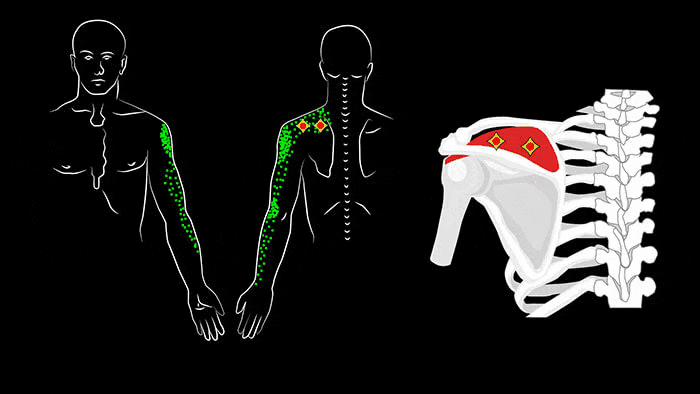The supraspinatus muscle can be the reason of development of pain in the shoulder joint and arm with epicenter in the deltoid region. And also cause clicks in the shoulder joint when the hand moves. I will show you exercises and useful recommendations, using which you can eliminate pain at home and prevent its future re-occurrences.

Supraspinatus Anatomy
The supraspinatus muscle almost completely covered by the trapezoidal muscle, and at the point of its attachment by coracoacromial ligament is also by the deltoid muscle.
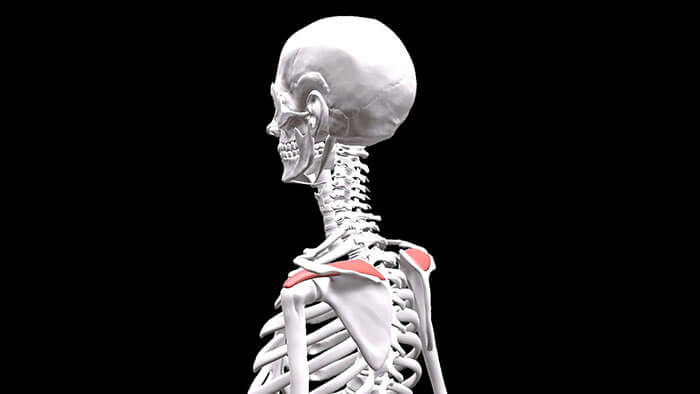
It starts from the walls of supraspinous fossa of scapula and narrowing it’s heading to the outward, passing under the acromion scapula and attaching to the upper edge of the humerus.
Supraspinatus Function
The main function of supraspinatus is abduction of the shoulder
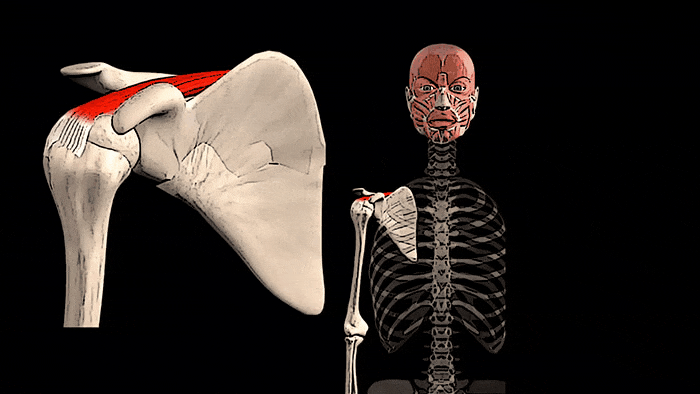
and also stabilization of shoulder joint and preventing the shifting of humerus head down, when the arm is dangling along the torso, especially in cases, when the arm is loaded with weight until it is completely exhausted. For example, when you carry a heavy bag for a long time and also while sudden arm-down.
Supraspinatus Trigger Points Diagram
Trigger points in the supraspinatus muscle cause pain in the region of the shoulder joint and downwards of the upper extremity. Triggers that are in the muscle center and close to its medial edge provoke deep and long-lasting dull pain in the shoulder joint with epicenter in deltoid region, that can go down the arm, concentrate in the area of lateral condyle of humerus and even reach the forearm switching to the wrist joint.

Pain in the elbow joint area сan be a diagnostic difference from pain, that is caused by trigger points of infraspinatus muscle.
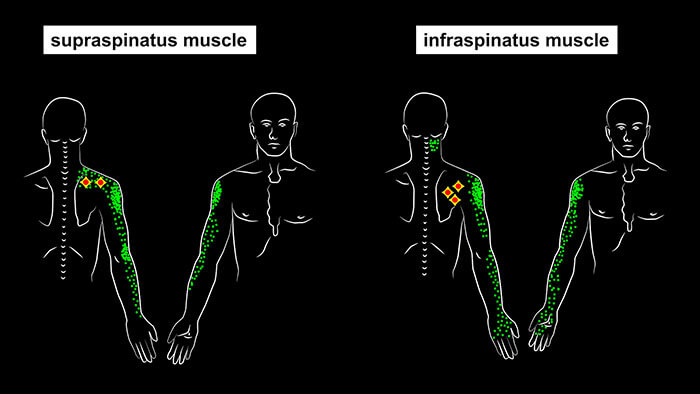
The trigger point that locates at the lateral edge of the muscle, at the attachment site of the supraspinatus muscle tendon to the shoulder joint capsule provokes pain only in the deltoid region.
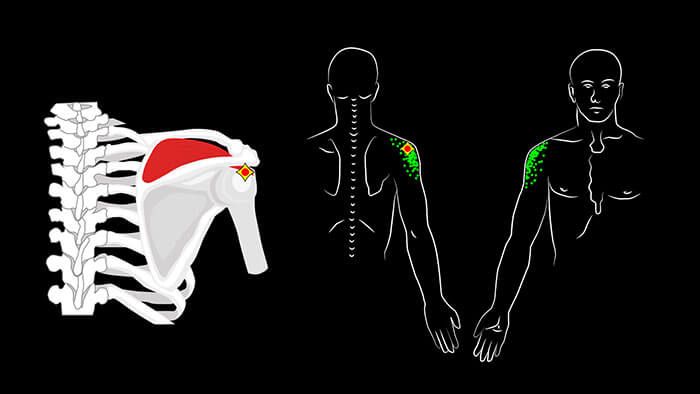
Pain can increase while forced abduction of the arm and also can take place at night, disturbing your sleep. In severe cases, the hand cannot be raised above the shoulder level. Some people can have clicks or crackling on in the shoulder joint region when the hand is moving. It happens, because tensed supraspinatus muscle interferes normal slip humerus head in the shoulder joint. The clicks can entirely disappear after eliminating trigger points.
If supraspinatus muscle is affected only on the side of the leading arm, then, in this case, due to limited shoulder abduction in the shoulder joint, there will be problems with combing hair, brushing teeth and shaving. Limited mobility and pain could become a real problem for training athletes. For example, volleyball and tennis players could face hardships while pitching.
Trigger points in the supraspinatus muscle can be activated during any severe overload, for example while lifting heavy bags, huge boxes, when arms lowered downwards are slightly sided,
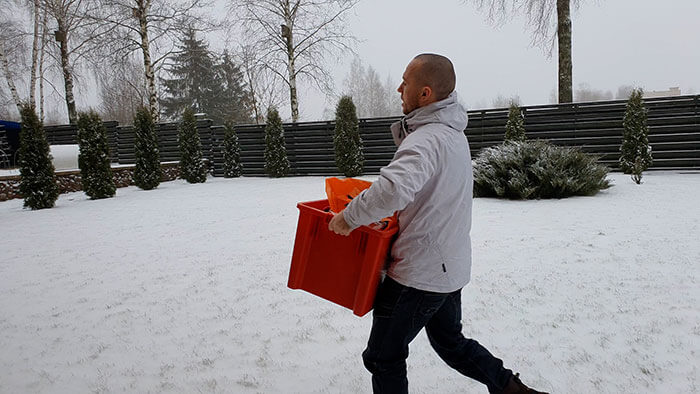
or while walking with a big dog, if it pulls on the lead or while doing work that requires prolonged arms lifting, for example while installing suspended ceilings. Any intense exercises with dumbbells, when arms to the sides, or for example, bench press from behind the head could also provoke activation of triggers and the development this pain symptomatology.
The supraspinatus muscle is rarely affected in isolation and almost every time combined with the upper trapezoid muscle and also with infraspinatus muscle.
Because the main area of reflected pain from the trigger points of the supraspinatus muscle is projected on the deltoid muscle location then when pain occurs in the shoulder joint region, we should also look for trigger points there.
Also, the widest back muscle could be incorporated in the pathological process. While being an antagonist of the supraspinatus muscle therefore the muscle that performs the opposite function – bringing the shoulder, elimination of trigger points in it and relaxation in the widest back muscle will increase the angle of shoulder abduction.
Supraspinatus Release
For working on the supraspinatus muscle at home you can use mechanical action technique on the trigger points followed by the stretching of the affected muscle.
Find the spine of scapula on your body and supraspinous fossa that is above it, in which there is the supraspinatus muscle. Then take a tiny massage ball of 8 santimeters and come to the wall. Roll the muscle to the right and to the left as its fibers move during one – two minutes and then having found the zones of tension, have even more strong mechanic impact on them during 30-60 sec.
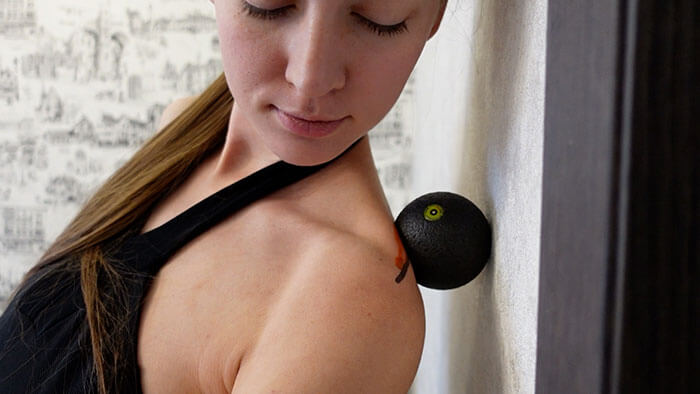
More intense impact on the area of trigger points you can have while lying on you back under the weight of your own body. but at first it can be a very painful procedure especially if you have large body weight. Be sure to roll the muscle the same way on the other part of the body.
Supraspinatus Stretching
Since the primary function of the supraspinatus muscle is the abduction of the shoulder in the shoulder joint then it will be maximum stretched while bringing your shoulder with your hand behind your back.
Point your arm on the affected muscle side behind your back and lift your hand towards the head. Raise your other hand above your head, reach your fingers towards each other trying to make a carpal lock.
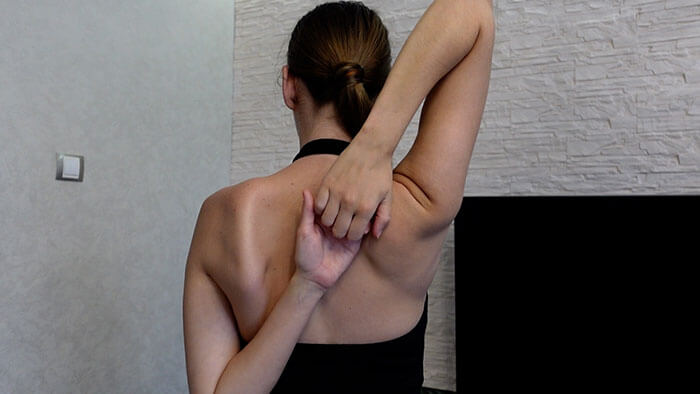
If the pain, when doing this, is severe or there is a significant restriction of hand mobility in the shoulder joint then take a belt, loop for yoga, towel or even a regular sock and grab it With your hands as close as you can get today. Hold the end position within 1-2 minutes. While stretching the muscle, breathe deeply and quietly and with each 4-5 exhalation try to get your hands a little closer together.
The supraspinatus muscle stretching at home can also be done under a warm shower. Do the same exercise by sending a stream of warm water to the shoulder blades area.
In my yoga workout sequences, that are gathered in this playlist, there are handgrip behind back exercises.
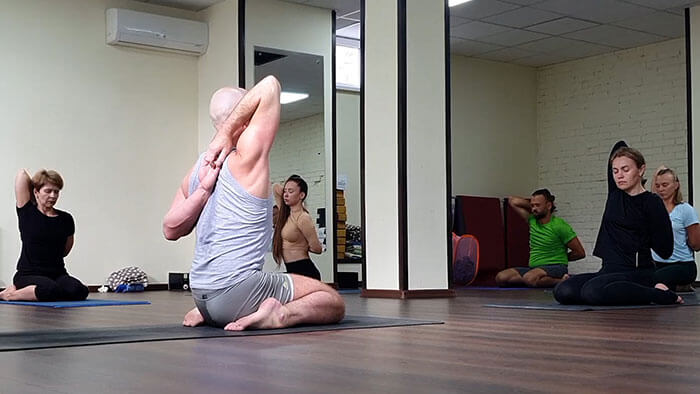
The ideal variant at home is myofascial release of all muscle of your body focusing problem areas followed by stretching the key muscle groups in the form of a fully balanced yoga complex. In the long run, this is a better option than an isolated exercise for only one muscle, in this case for supraspinatus one.
It should be understood that if the supraspinatus muscle is in chronic tense, then this is most likely due to uneven muscle development in the shoulder joint area. And other antagonistic muscles could be in a weakened state.
To form the evenly developed muscle corset around the shoulder joint and thus to contribute preventing the recurrence of trigger points in the supraspinatus muscle. I highly recommend in addition to practicing yoga to learn at least a few simple exercises with a stick.
I recommend to integrate these exercises into your life not only for those who has problems with the shoulder joint, but also in general with arm, cervical and thoracic spine.
